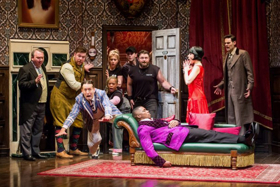Review: You Can't Go Wrong With THE PLAY THAT GOES WRONG

The Play That Goes Wrong
Written by Henry Lewis, Jonathan Sayer, and Henry Shields; Original Broadway Direction by Mark Bell; Tour Directed by Matt DiCarlo; Scenic Design, Nigel Hook; Costume Design, Roberto Surace; Lighting Design, Ric Mountjoy; Sound Design, Andrew Johnson; Original Music, Rob Falconer; Production Stage Manager, Jeff Norman
CAST (in order of appearance): Brandon J. Ellis, Evan Alexander Smith, Yaegel T. Welch, Peyton Crim, Scott Cote, Jamie Ann Romero, Ned Noyes, Angela Grovey
Performances through November 18 as part of 2018-2019 Lexus Broadway In Boston Season at Emerson Colonial Theatre, 106 Boylston Street, Boston, MA; Tickets at Box Office, (888) 616-0272, or www.BroadwayInBoston.com
The Play That Goes Wrong gives new meaning to the phrase "brings down the house," as the amateur actors of the Cornley University Drama Society do their best to stage The Murder at Haversham Manor while everything that can possibly go wrong...does! An incredible ensemble cast is almost outshone by Tony Award-winner Nigel Hook's integral scenic design, but their precision physicality and abundant joy in utilizing his playground puts them in the much deserved limelight. The tour of the hit Broadway comedy, still running on the Great White Way until just after the New Year, has audiences rolling in the newly-refurbished aisles of the Emerson Colonial Theatre through November 18th as the season opener of the Lexus Broadway In Boston series.
Written by Henry Lewis, Jonathan Sayer, and Henry Shields, colleagues from the British Mischief Theatre Company, The Play That Goes Wrong is structured as a play-within-a-play, about a troupe of seemingly-cursed actors whose bumbling is paired with equally clumsy and inept stagehands. They take themselves seriously, stoically plodding on through each and every disaster that befalls their staging of the aforementioned murder mystery. Missed lines, mispronounced words, and misplaced props are merely the tip of the iceberg that all but sinks their Titanic-like production. Meanwhile, the worse it gets for them, the better it gets for us, with nonstop, laugh-inducing antics that relentlessly roll up against the non-existent fourth wall like waves breaking on a beach.
The tour is directed by Matt DiCarlo, whose resumé must include special skills as juggler, choreographer, and military strategist, as he has taken command of an octet of actors and shaped them into a unit that looks like it is falling apart, even as it operates seamlessly across the pitfall-laden interior of Haversham Manor. Evan Alexander Smith doubles as the long-suffering and harried director of the C.U. Drama Society's play and Inspector Carter, the not-so-insightful detective called in to solve the crime. The suspects include Thomas Colleymoore (Peyton Crim), Cecil Haversham (Ned Noyes), brother of the deceased, Florence Colleymoore (Jamie Ann Romero), fiancée of the deceased, and the butler, Perkins (Scott Cote). Yaegel T. Welch (Charles Haversham) is rather animated for a dead man, and both stagehands (Angela Grovey, Brandon J. Ellis) are actively involved in the production. So incredibly effective as an ensemble are they, it seems pointless to talk at length about any one of the performers. All exhibit masterful timing and delivery (their synchronized spit-takes are especially impressive), and manage to keep their heads while chaos swirls around them.
Hook's unit set is the equivalent of a ninth character, and Ric Mountjoy's lighting design adds both dramatic and comedic effects. Original music by Rob Falconer and sound design by Andrew Johnson add flavor to the mystery, and Roberto Surace's costume design evokes the styles appropriate for the 1920s murder in a country house, and also provides definition and flair to the personalities of each of the characters. The design elements do not merely serve the story, but contribute to its telling. Inanimate objects are instruments of humor in the hands of this crew, and they create a constant drumbeat of laughter, the most beautiful music of all.
Photo credit: Jeremy Daniel (Ensemble of The Play That Goes Wrong)
Add Your Comment
To post a comment, you must register and login.Videos
.png)